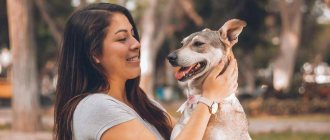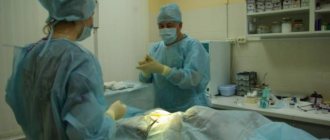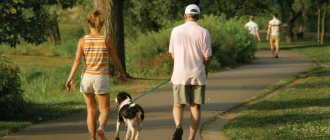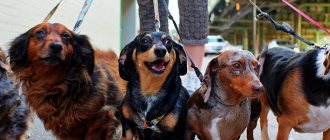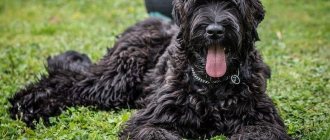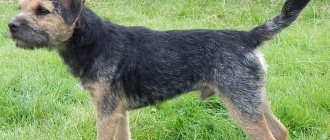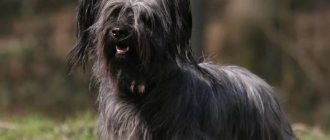Breed characteristics
| Short description | |
| Origin: | USSR |
| Conditions of detention: | In a house with a large garden |
| Purpose: | Sentry |
| Color: | Black |
| Wool length: | 5-15 cm |
| Adult dog size: | The height of females is 68-72 cm, males 72-76, weight of males is about 50-60 kg, females - 45-50 kg |
| Average life expectancy: | 9-14 years |
| Walk: | Puppies are walked 5 times a day, an adult dog 2 times a day |
| Physical activity needs: | Average physical activity needs (walking 1 to 3 hours per day) |
| Fédération Cynologique Internationale (FIC) classification: | Group No. 2 Pinscher and schnauzer, Molosser, mountain and Swiss cattle dogs; Section No. 1 pinschers and schnauzers |
| Puppy price: | From 10 to 30 thousand rubles.
|
Breed standard
The standard for this breed is as follows:
- appearance: large dog with a proportional build and developed muscles, height in males 72-76 cm, in females 68-72 cm;
- elongated head, wide skull and round cheekbones; woolly mustache and beard make the head appear rectangular;
- the ears stand high, have a triangle shape and hang down from the cartilage;
- 42 teeth, scissor bite;
- the neck is well developed, follows the length of the head, and is quite massive;
- body with a wide and deep chest, convex ribs, well-developed and long withers, the back has well-developed muscles;
- the tail is thick, docked at the 3rd vertebra, stands high;
- limbs are parallel and straight, shoulder blades are set correctly, long, shoulders are medium, hips are wide;
- rounded paws, dark claws;
- the coat is coarse, there is a fur coat, mustache and beard, the undercoat is soft;
- the color is exclusively black, there may be patches of gray hair;
- movements are fast, paws move straight, jumps are long due to strong hind limbs.
History of the origin of the species
Stalin's dog was first bred for the Russian army at the end of World War II. This breed can work in harsh climate conditions: heat and cold. Three breeds were used to breed it: the huge schnauzer, the Newfoundland and the Airedale terrier.
Black terriers were highly valued in Russia not only as highly skilled and courageous service dogs, but also as loyal and devoted pets.
These dogs were used by the Red Army to track down fugitives.
RUSSIAN BLACK TERRIER BREED STANDARD. MOVEMENTS:
Movements are free and balanced. The characteristic gait is an energetic, sweeping trot, due to the strong push of the hind legs and significant reach of the forelimbs. The joints of the limbs bend and extend freely. The back remains strong during movement and, together with the lower back, is slightly springy.
An energetic, sweeping trot with a large grasp of space in the forelimbs is possible with a strong push from the hind limbs. The weaker the push, the shorter the step. The strength of the push depends not only on the strength of the ligaments and strong muscles, the correct structure of the hind limbs and croup, but also on the proportionality of the build of the body as a whole. The photo (Fig. 9 a, b) shows how the lower back and back spring when pushing forward movements are transmitted. The Black Terrier, which has a square body, can walk in a balanced manner, but with a short stride. According to Elliot R., in order for the power of the drive from the hind legs to be balanced with the stride of the front legs, the dog must have a slightly stretched format and correct proportions. The Black Terrier is a fairly high-legged dog: the height at the elbow is 50-52% relative to the height at the withers. The short body of such a dog, which also has significant weight, will not contribute to productive, sweeping movements. Sometimes you can see a black terrier seem to move freely, but the hind limbs do not fully extend after a push. With balanced movements, the right and left pairs of limbs, which are in antiphase (Fig. 9 a, b), work in harmony. Under the short body there is not enough space for the work of the pair of long limbs located under it, the dog reduces the force of the push, and the hind limb of the pair, which goes into antiphase, does not fully extend. Incomplete extension of the hind limbs during the swing and the force of the push may also be associated with weakness of the ligamentous apparatus.
Fig.9. Movements at an energetic sweeping trot: a - before the push of the left hind (the right pair of limbs is in antiphase to the left pair), b - before the push of the right hind (the left pair of limbs is in antiphase to the right pair). During the push, the lower back is slightly convex, tense, after the push it will straighten out like a spring, transmitting the pushing movements forward, the back is also tense.
When moving slowly, the Black Terrier can carry its head at an angle of 45°. With accelerated movement, the trot is more sweeping, more effort is required to transmit pushing movements forward, the neck extends almost parallel to the plane of movement, regulating the transfer of the center of gravity. But, depending on the type and structure, the dog may move differently. For example, very heavy and rough (with its exterior flaws) - a shortened trot, turning into a heavy gallop; dry and light - also a short trot, but turning into a light gallop (the natural gait of “terriers”). The movements of black terriers should be free, sweeping, but not easy.
Distinctive features
The main distinguishing features of the Black Russian Terrier are:
- The head is proportional to the body. It is equal to the length of the neck and at least 40% of the height of the dog at the withers.
- The eyes are oval, medium in size, dark and relatively widely spaced.
- The ears are medium in size, triangular in shape, high, but not higher than the level of the skull. The skin of the ear is dense, rounded towards the bottom, hanging with the leading edge on the head.
- The muzzle is wide with a slight narrowing towards the nose. The mustache and beard emphasize the volume and give it a square shape.
- The nose is large and black.
- bite . The teeth are large and white. The incisors form a straight line at the base.
- The neck is muscular and powerful. The length is the same as the length of the head.
- The body gives the impression of an oval sternum with wide and well-proportioned ribs.
- The tail is thick, set moderately high and at 45 degrees horizontally. The shape resembles a sickle or saber.
- Color only black.
Until 2007, in all countries of the world the tail of the black Russian terrier was docked; now this procedure is prohibited.
BLACK TERRIER NECK:
The neck is massive, dry, muscular, approximately equal in length to the head, set at an angle of about 45° relative to the horizon. The scruff is strong and well defined.
The black terrier's neck is massive, well muscled , not long, with a fairly pronounced scruff. weakly muscled neck without a scruff with a massive head and voluminous body makes a depressing impression, which groomers need to take into account when cutting the scruff. The neck regulates the transfer of the center of gravity during movement, therefore a well -muscled , strong neck, as well as its posture, are especially important for the heavy black terrier. The posture of the neck is associated with the structure of the glenohumeral joint. As a rule, a high carriage of the neck (long, elegant and dry, like a terrier) is accompanied by an increased angle of the shoulder-scapular joint. Low neck posture corresponds to a reduced angle of the glenohumeral joint. Both options lead to impaired functionality of movements. The optimal neck position for a Black Russian Terrier dog is 45 degrees to the horizon.
Photo of an adult dog
Photos of puppies
Features of character and behavior
The Black Russian Terrier has a very calm, confident and safe character. He is extremely friendly and outgoing towards his family, but is aloof and distrustful of strangers due to his natural protective instinct. This breed is very good with children and is very trainable. Black Terriers do not suffer from separation anxiety, making them an ideal watchdog.
Black Russian Terriers form strong bonds with their owners and always try to please them. However, for proper training, it is necessary to indicate to the dog who is dominant in the house. This breed is very energetic and is well suited for people with an active lifestyle. In addition, they are well suited for guarding the house and hunting wild animals. At the same time, they do not conflict and do not behave aggressively towards other pets.
Black Russian Terriers are very playful, so they need long walks.
Advantages
The main advantages of this breed include:
- Strong and robust physique;
- Big sizes;
- Harmonious physique;
- Good health;
- Easy to care for;
- Mind;
- Lack of aggression towards children and other pets;
- Wary of strangers;
- Adaptability to heat or cold;
- No seasonal shedding.
Flaws
Along with the advantages, there are also disadvantages, which include:
- The coat requires constant trimming and combing;
- Puppies under 1 year of age require careful and strict training;
- Not suitable for beginners;
- An adult dog needs long and hard training.
How to clean your ears
A black terrier's ears, like any other dog with floppy ears, need to be cleaned monthly.
The fact is that the ear canal of black cats is very long and tortuous - an inheritance from their Newfoundland ancestor. It is poorly ventilated, therefore the dog's ears become inflamed easily. Regular ear cleaning - removing hair, wax, etc. - reduces the likelihood of inflammatory processes. Immediately before cleaning, wipe the inside of the hanging part of the ear with a cotton or gauze swab moistened with hydrogen peroxide; immediately after that, remove any remaining peroxide with a dry swab. The fur on the inside of the shell is removed with your fingers, grabbing it in small strands so as not to hurt the dog or damage the skin. The fur inside the ear canal is gradually removed using tweezers with rounded ends or using regular eyebrow tweezers. After the process is completed, drop a pipette of warm calendula tincture into each ear, cover the ear with your palms and lightly massage. Don't be alarmed if after this your dog behaves somewhat restlessly, shaking his ears and head - for any dog, ear cleaning is not a very pleasant procedure. But what to do? It is better to endure cleaning and plucking from time to time than to regularly suffer from otitis media.
Care and maintenance
The black terrier lives well both in an apartment and in a house on the ground. All he needs is a place to train and play. In addition, a large bed that is not electrified will be enough for him.
This breed does not require special care. Due to its thick coat, the dog needs to be bathed once a month and preferably brushed daily. However, you must remember to trim your nails once a month and clean your ears once every 2 weeks. Debris may collect in the corners of the eyes, which should also be removed with a damp cotton pad.
In addition, they need regular physical activity in the form of games and jogging. These dogs love to be near people, so keeping them in a kennel is unacceptable.
Nutrition
For the Black Russian Terrier, high-quality food should be carefully selected. This can be dry food from a commercial manufacturer, when choosing which it is important to take into account the quality of raw materials and the amount of useful ingredients. Or food prepared at home, in compliance with all proportions:
- Proteins – 20% or 4 g/kg.
- Fats – 5% or 1 g/kg.
- Carbohydrates – 75% or 15 g/kg.
Any diet should be appropriate for the age of the dog (puppy, adult dog, elderly).
Some terriers tend to be overweight, so monitoring their caloric intake is essential for weight control.
It is very important that your dog always has access to clean and fresh water.
Prohibited products include:
- Sweets;
- Smoked and fried foods;
- Fatty meat products;
- Tubular bones.
While the Black Russian Terrier is a puppy, it must be fed properly, usually 4-5 meals; veterinarians recommend the following amount of natural food per day:
- 2 months – 286-357 grams;
- 3 months – 365-460 grams;
- 4 months – 400-495 grams;
- 5 months – 454-577 grams;
- 6 months – 505-649 grams;
- 7 months – 506-650 grams;
- 8 months – 471-646 grams;
- 9 months – 440-606 grams;
- 10 months – 402-570 grams;
- 11 months – 365-525 grams;
- 12 months – 363-483 grams;
- 14 months – 357-476 grams.
After 15 months of life, the dog is considered an adult, and it needs to be fed 2 times a day, depending on its body weight:
- Up to 36 kg – 352-463 grams;
- Up to 45 kg – 409-538 grams;
- Up to 60 kg – 459-588 grams;
- Up to 68 kg – 509-638 grams.
In order to avoid problems with obesity, you need to consult a veterinarian on choosing the right diet.
We recommend that you read a detailed article on the topic: “How and what to feed a dog: types and characteristics of nutrition.”
Health
The Black Russian Terrier is in good health. Its lifespan ranges from 9 to 14 years . Despite their relatively long lifespan, these dogs, like most large breeds, are predisposed to certain hereditary diseases.
Vaccinations
Vaccinations for Black Russian Terriers are carried out in the same manner as for other breeds. Vaccination is carried out to prevent such terrible diseases as distemper and rabies. First, the primary vaccination is given, then revaccination is done. Typically, intramuscular or subcutaneous injections are used for this.
The vaccination schedule includes vaccinations against the following diseases:
- Rabies - at 3 months, then a year and repeat annually;
- Plague – 2 months, then a year and repeated annually;
- Infectious hepatitis - every 2 months, every year and repeated annually;
- Parvovirus enteritis - at 2.5 months, per year and repeated annually;
- Canine parainfluenza – 2 months, per year and repeated annually;
- Leptospirosis – 2.5 months, per year and repeated annually;
- Trichophytosis - 6 months, per year and repeat annually;
- Microsporia – 6 months, per year and repeated annually.
It is important to vaccinate dogs annually to avoid infectious diseases.
Important article on the topic: “Everything you need to know about dog vaccinations.”
Diseases
Canine studies have shown that the Black Russian Terrier is susceptible to such diseases as:
- Hip dysplasia . This is a condition where the hip bones do not develop properly. Later it can lead to concomitant diseases such as arthritis. X-rays are used for diagnosis, and then a veterinarian looks at the images. Although hip dysplasia has a genetic risk factor, its development can also be influenced by the environment.
- Elbow dysplasia . This is a condition in which abnormal bone development occurs, leading to arthritis in old age. Diagnosis occurs by x-ray examination. The leading risk factor is genetic predisposition.
- Hyperuricosuria . This is a disease in which uric acid does not dissolve, but forms crystals, which subsequently leads to urolithiasis. Most often, this disease affects dogs aged 3 to 6 years.
- Polyneuropathy . This pathology occurs with degenerative disorders in the nervous system. Clinical symptoms of this disease include problems with the hind legs and difficulty breathing, especially after physical activity.
- Ear infections . They are common due to the position of the ears of Russian Terriers.
When the first symptoms of incipient diseases appear, you should contact a veterinary clinic.
Walk
Black Russian Terriers are very active dogs. They require 40 minutes of daily training. Black Terriers in particular love lively walks in nature, and they will also be a good partner for cycling, swimming and even hiking. These dogs are always happy to play catch or frisbee.
This breed physiologically needs great physical activity. If you don’t deal with it, the consequences can be unpleasant and destructive. If a dog does not spend enough time with its owners, it may develop aggressive behavior.
Grooming
Stalin's dog has a thick, soft undercoat covered with a coarse protective layer that requires regular brushing and trimming to avoid blobs. To do this, you need to comb the dog with a long-toothed comb 2 times a week. This allows you not only to tidy up the coat, but also to improve blood flow under the skin.
In addition to trimming the fur itself, it is necessary to trim the dog's beard and whiskers carefully so that they look well-groomed and do not collect debris.
An untrimmed dog's muzzle can collect and bury food debris, leading to an unpleasant odor.
It is necessary to bathe your dog at least once a month, this will get rid of parasites and prevent an unpleasant odor. Regularly checking and cleaning your ears will help prevent ear infections.
Maintenance and care
Black Russian Terriers prefer to spend most of their time outside in an enclosure or in the courtyard of a country house. When keeping a dog in a city apartment, it is necessary to walk the dog as often as possible.
Black Russian Terriers are a versatile breed. They adapt well to very harsh weather conditions, but also do well in temperate climates. Representatives of the breed prefer to spend time in a spacious outdoor enclosure or in the garden of a country house rather than in the limited space of a city apartment.
Terriers need long walks at any time of the year and great physical activity. It is recommended to visit special areas where the dog can run without a leash or muzzle and participate in agility for at least 30–60 minutes a day.
Basic procedures
Black Russian Terriers have long, thick hair that requires careful grooming. An important feature of the breed is the complete absence of shedding.
Since the hairs do not fall out, they tend to fall into multiple tangles. That is why special attention should be paid to combing wool.
Combing
Brushing the animal should be done a couple of times a week. For this process you will need the following tools:
- a tangle cutter in the form of a rake with wavy, blunt tips - a device that can be used to divide large tangles into smaller ones;
- a comb with long teeth for combing out small tangles;
- slicker brush for combing out fluff, dead hairs and dust;
- trimming comb for final combing and giving the coat a decent look.
Water treatments
It is necessary to comb your pet before bathing, which can be done no more than once a month or as it gets dirty. In this case, you should use a special shampoo. The dog's paws and belly become very dirty after long walks and need to be rinsed with water daily.
Terriers' long mustaches and beards also get very dirty after eating. It is recommended to wash them with clean water and comb them daily, and after the animal drinks, be sure to blot them dry with a clean cloth. A beard is no less prone to tangles than a fur coat, so it requires special care. It must be washed with shampoo once every seven days and combed thoroughly. The fur under the collar also requires regular inspection. It should always remain dry and clean.
You can't help but dry your decorating hair. Wet long fur can develop a fungal infection that can be detrimental to your dog's health.
Hair cutting
Another important procedure for Black Russian Terriers is grooming. The dog should be groomed according to the established standard at least once a quarter. The first hygienic haircut is given to puppies at 6 months. You will need sharp hairdressing scissors, thinning scissors, a long-toothed metal comb and a slicker brush. A high-quality dog clipper will also work.
Many owners have a question about what length of coat to leave for the Black Russian Terrier. It all depends on personal preferences; some people like dogs with fairly long hair, while others like them with short hair. The recommended hair length for a short haircut is up to 1.5 cm, for a long haircut – from 3 to 6 cm.
You can also cut according to the following scheme. In this case, the length of the hair in certain areas must correspond to the indicated length of the hairs in the picture
Nail care
The dog's claws are quite powerful and long. To prevent them from breaking or overgrowing, they must be trimmed at least once every two months.
Only the transparent part of the nail should be treated so as not to damage the pulp and blood vessels. It is recommended to trim the hairs between the fingers and the pads; tangles can also form on them, causing discomfort when walking.
Hygiene of the ears, eyes and mouth
Once a week it is worth examining your pet's ears and eyes. It is important to ensure that there is free access of air through the ear canal. To do this, all vegetation is cut out of it. This should be done with nail scissors with blunt or rounded tips. At the same frequency, it is necessary to remove accumulated secretions from the pet’s eyes with a damp cotton swab.
Weekly dental care (3-4 times every 7 days) is a must. To do this, use paste and a brush for animals. Solid food is used to prevent the formation of tartar.
Advice from experts on maintaining a decent-looking coat
Over time, a terrier's fur coat becomes too rough to the touch and faded. To prevent this, you must follow a few simple rules:
- do not leave your pet in direct sunlight for a long time, otherwise the fur will turn brown;
- do not use a hair dryer to dry it to avoid over-drying and the appearance of a gray coating on the hair;
- do not carry out water procedures in hot or cold water, otherwise it is very easy to lose the natural hardness and shine; use only warm liquid for washing;
- monitor the air humidity in the room where the dog is most often located; dry air can make hair brittle;
- use medium-hard combs to avoid splitting, and dry the coat thoroughly before combing;
- Organize a balanced diet for the animal and, if necessary, use vitamin complexes.
Education and training
The training of the Black Russian Terrier should be left to professionals. The behavior of an adult black terrier is difficult to correct.
Breeders of large dogs with pronounced guarding and service qualities must take into account that such a pet requires serious training and proper upbringing, regardless of the purpose for which the animal is purchased. This is the only way to turn an aggressive giant into a loyal friend and companion.
Since the Black Russian Terrier is primarily a service dog, its obedience and ability to obey its owner must be honed to the point of automaticity. The training of such a serious breed should be entrusted to an experienced dog handler. Correcting the behavior of an older pet will be much more difficult than training it correctly from an early age. During the period of growing up, you need to socialize the terrier as much as possible, allowing him to contact people as often as possible, especially with family members or guests at home.
Training recommendations:
- be patient and get the puppy to fully comply with the following commands: “Come to me”, “Sit”, “Nearby”, this is the only way to achieve unconditional obedience;
- use tricks such as pieces of treats or praise when training, but do this only if the animal has followed the order exactly;
- allow the pet to independently assess the situation in some cases, without completely suppressing its natural skills;
- do not shout, do not change intonation, avoid emotions such as anger and irritation, give commands in an even and calm tone with moderate notes of firmness;
- physical punishment should not be used, because representatives of the breed remember them very well, the offending animal should be scolded immediately after a mistake has been made, after some time the dog simply will not understand why exactly it is being punished;
- to constantly train a pet at home, every unconscious action of the dog must be accompanied by a command from the owner, for example, if the pet is sniffing something, give the command: “Sniff,” if it is looking at any object, give the command: “Observe,” etc.
Proper nutrition
Proper nutrition is not only the key to the health of the Black Russian Terrier. A well-chosen diet helps maintain the beautiful appearance of an animal’s coat for a long time.
Large breeds such as the Black Russian Terrier especially need a diet that is balanced in composition and content of nutrients. Breeders recommend feeding “black giants” with industrial food of the “super-premium” and “holistic” classes with a protein content of at least 30%. The daily norm for an adult dog with optimal physical activity and weighing over 50 kg is 560 g.
With a natural type of feeding, the weight of the daily portion should be equal to 3% of the animal’s weight. The basis of the diet should be proteins. Approximate power supply:
- raw frozen or boiled lean meat, for example, lamb, beef, turkey (50% of the total food);
- raw frozen or boiled offal, boiled sea fish (20%);
- fresh or steamed vegetables (up to 20%);
- bones (10%).
Several times a week you can offer your pet fermented milk products: kefir, cottage cheese. Hard cheese and egg yolk are suitable as delicacies. Don’t forget about additional vitamin and mineral complexes, which will provide the animal’s body with the missing nutrients.
Veterinarians do not recommend feeding your pet from your table. You should especially not give smoked, sweet, salty, or fatty foods.
A black terrier puppy up to 6 months is fed 4–5 times a day. After six months, you can transfer your pet to twice feeding in the morning and evening.
Mating
Usually dogs of the same class are taken for mating. The show class is never bred with standard dogs. For a female that has a pedigree that has won several titles at exhibitions, a corresponding male is selected. To do this, the nursery takes special permits and evidence of belonging to this class.
Along with this, pairs are selected taking into account their type, character, and the male should also be larger than the female in size.
The age for mating varies: for females it is 2.5 years (usual after 3-4 heats), and for males it is 1.5 years. It is advisable to introduce the dogs before mating, but this is not a prerequisite. Mating is carried out on neutral territory to avoid conflict.
Read a detailed article on the topic: “Everything you need to know about breeding dogs: appropriate age, what to do if it doesn’t work out, rules and tips.”
How much does it cost and how to choose a puppy?
The cost of a puppy depends on who you buy it from. At bird markets you can see prices ranging from 5,000 to 60,000 rubles. In a good nursery, such a breed will cost an average of 30-80 thousand rubles, which depends on the pedigree and titles of the parents, the exterior and health of the puppy, mating (scheduled, unscheduled, away).
Puppies
Since you are getting a serious working dog, it is best to buy from reputable breeders. You will look at the pedigree and learn about possible hereditary diseases of the animal. Your pet will be given documents, and you will be told what to feed it and how to care for it. Such sellers are ready to advise you at any time, even over the phone.
Attention! The minimum age for purchasing a puppy is 2.5-3 months, after microchipping and first vaccination. Do not forget that after vaccination the baby needs a 2-week quarantine, so it is better for him to spend this time near his mother.
When choosing a Black Russian Terrier, pay attention to its coat, the color of its eyes, nose, condition of its paws, ears, and tail. He should not be afraid of you or, on the contrary, growl and try to bite. But no one guarantees you that your pet will become a star; there can be many surprises.
Key points in training
Training is an integral part of any dog's life. The Black Russian Terrier has very good discipline, this is its meaning in life. This means that he is highly trainable and will follow his owner’s commands. In order to achieve results in training, constant repetition of what has been learned is necessary, so the dog will learn the information better.
An important fact is that this breed needs a lot of mental stimulation and consistency. This is important to prevent the development of unwanted behavior. Before you start teaching your dog special skills, you need to teach him basic commands, which include:
- To me;
- Place;
- Sit;
- Lie;
- Stop;
- Ugh.
Basic commands will help to avoid further problems during training, which will make it more productive.
Read about how to properly train a dog in the article: “Training a puppy: effective methods from dog handlers, learning commands at home.”
Appearance of Stalin's dog
Toy Terrier (Russian and Moscow): description of the breed
The distinctive features of the Black Russian Terrier are their large build and thick, long hair. The weight of an adult dog is from 40 to 60 kg. The 1984 breed standard states the following:
- height at withers 65-70 cm;
- body length slightly elongated;
- general appearance - a massive dog with large wide bones;
- the head is proportional to the overall physique;
- massive muzzle;
- fur on the face in the form of a mustache and beard, bangs covering the eyes are allowed;
- ears are medium in size, drooping in the upper third;
- paws are straight and wide, overgrown with hair;
- the tail is short, thick at the base;
- all parts of the body are massive, large, well defined, but without sharp transitions.
Note! The color of the coat is always constant - coal black, without interspersed with other shades. The black terrier has very thick hair, abundantly covering all parts of the body.
The difference between dogs of different sexes is clearly visible - males are much larger than females.
Male and female black terrier
How to choose a puppy
Choosing a puppy is very important because it cannot be changed or given away. When purchasing a dog, you need to understand that this is a family friend who will live with it not for a year or two, but for 10 or even 14 years. If you raise a puppy correctly, he will grow up to be a good guard dog and a faithful companion.
When buying a puppy, there are many aspects to consider in order to avoid problems in the future. These tips will help you choose a Black Russian Terrier puppy:
- Beware of scams . It happens that many advertisements offer beautiful puppies at low prices. However, sellers in this case ask for part of the money as an advance payment. Therefore, you should not buy a puppy over the Internet; it is best to come to the nursery and look at it.
- Mixed puppy . Quite often, nurseries began to cross various breeds with the Russian Terrier. As a result, a large number of non-purebred dogs appeared. While they are small, it is quite difficult to notice the difference, however, when the dog grows up, the features of a different breed will be clearly visible. In order to avoid this, it is necessary to request information from breeders about the parents of the puppies; it is desirable that this be documented information that indicates the breed and marks.
- Small puppy size . If the puppy is smaller in size than the others, then you should not assume that it will grow up healthy. Most often, these dogs are susceptible to diseases. You should select a puppy strictly according to proportions.
- When purchasing, you must make sure that the puppy’s parents have been vaccinated and have no hereditary diseases.
- Behavior . When choosing, you need to sit down and see how the puppy reacts; if he jumps away from fear towards the wall, this means that he is timid and will not be a good watchdog.
A good breeder will always answer all questions about the pedigree and parents of the puppy.
In conclusion, it should be noted that the Black Russian Terrier is an excellent companion and a good watchdog and hunting dog. He has excellent qualities and discipline for this. This dog is easy to care for, has a long lifespan and is easy to train. These important characteristics make it possible to make it not just a guard dog, but also a beloved family member. Black Russian Terriers are well suited for experienced and active people who love and carefully raise dogs.
STANDARD RUSSIAN BLACK TERRIER. LIMBS:
FORE LIMBS:
Viewed from the front, straight and parallel. When viewed from the side, the shoulder blades are long, wide, and set obliquely. The shoulder angle is about 100°. The shoulders are no shorter than the shoulder blades, muscular. Elbows point straight back. The forearms are thick, rounded, straight, of medium length, vertically set when viewed from the front and side. The pasterns are short, massive, set slightly obliquely when viewed from the side. The height at the elbow (at the level of the olecranon process) is 50-52% relative to the height at the withers.
The forelimbs are straight in front and parallel, with long wide shoulder blades, the humerus bones are set obliquely, equal in length to the shoulder blades. The angle of the glenohumeral joint is close to 100° (Fig. 7). For a heavy dog with a moderate temperament, the correct structure of the front part of the body is especially important, since the movements of the black terrier occur with a greater load on the front. When moving, the shoulder girdle (shoulders, shoulder blades, withers, their joints and strong ligaments and muscles), which is involved in maintaining balance, braking and turning, experiences a large load. The correct structure of the shoulder-scapular joints and strong broad muscles on the shoulders ensure a significant reach of the forelimbs in movement.
Fig. 7 Angles of articulation of bones in the joints of the fore and hind limbs. ABC - angle (~100°) of the glenohumeral joint, AB (scapula) ~ equal to BC (shoulder)
Increasing the angle (ABC) of the glenohumeral joint leads to straightening of the shoulders (that is, a terrier “front” appears) and a shorter stride. A decrease in angle is usually associated with a loss of high forwardness. At the same time, the dog is able to move expansively, but spends a lot of energy on straightening the shoulder-scapular joint, quickly gets tired and goes into a gallop. Thus, both options lead to changes in the functionality of movements. An angle of 100° , as well as the equality of the lengths of the shoulder blade and shoulder, ensure the strength of the bones of the entire shoulder girdle; at the same time, the olecranon process is located under the withers. The forearms are vertical and strong. It is important that the process of the ulna is directed strictly backward. Its position is controlled by the position of the forelimbs: the elbows are excessively pressed to the body when marking and, conversely, the elbows are turned outward when clubfoot. The pasterns are strong, slightly sloping forward. With vertical pasterns, the so-called “kozinets” (movement forward of the wrist joint) is possible. In this case, the metacarpus does not function as a shock absorber, which can lead to serious injuries to the limbs.
HINDQUARTERS:
When viewed from behind, straight and parallel, set slightly wider than the front ones, set slightly back. The thighs are quite long, somewhat obliquely set, wide, with well-developed volumetric muscles. The shins are set obliquely, no shorter in length than the thighs. The angles of the hock joints are well defined. The hocks are massive, not long, set vertically.
The hind limbs are strong, powerful, set slightly wider than the forelimbs (Fig. 8). They must have clear, balanced angulations, provide strong propulsion, and be coordinated with the forelimbs in movement. The wider set of the hind legs provides strong support and stability when pushing.
Fig.8 Position of the hind and forelimbs: AB - perpendicular, lowered from the sacrum; CD—width of hind limbs; EF — width of the front legs (CD > EF)
In the stance, the stance of the hind limbs is slightly pulled back: the paws of the hind limbs should be behind the perpendicular line lowered from the sacrum (Fig. 8, line AB), but not too far. Usually, strongly pronounced (sharply protruding) ischial tuberosities are associated with a short croup: a short croup is, as it were, “compensated” by long pelvic bones. The shins are approximately equal in length to the thighs or slightly longer than them. The width and volume of the femoral muscles depend both on the length and set of the hips, and on the length of the croup. With a narrow and short croup, the hips are not wide, and, therefore, the muscles are not wide enough and voluminous. The metatarsus are almost vertical, not long. Excessively long metatarsals or shins lead to a saber stance; shortened bones of the thighs, legs or short metatarsals - to a straightened posture. Lengthening or shortening of the bones of the thighs or legs is one of the reasons for the imbalance of the angles of the stifle and hock joints and, as a result, leads to a weak push in movement. The joints of the hind legs must be formed correctly: the angles of the knee and hock joints must be moderate, the joints must flex and extend well and have strong ligaments. Only such a balanced structure, held together by strong ligaments and equipped with strong muscles, can provide functional movement for the dog.
ABOUT THE RUSSIAN BLACK TERRIER BREED — FEET: large, arched, balled, rounded. The hind legs are slightly smaller and more oval than the front legs. Claws and pads are black. Dewclaws should be removed.
Photos from owners of the Black Russian Terrier breed
[webnavoz_instagram json=”{'link':'https:\/\/www.instagram.com\/p\/BXQphxwnStk\/','author':'lis_photos','link_img':'https:\/\ /instagram.fhen1-1.fna.fbcdn.net\/vp\/0b06a4d70ae094e24cf15b72b1dfab44\/5D41FAD4\/t51.2885-15\/e35\/20479259_193526901184340_6897855225567 117312_n.jpg?_nc_ht=instagram.fhen1-1.fna.fbcdn.net '},{'link':'https:\/\/www.instagram.com\/p\/BeTRpFKleC_\/','author':'irina_brt','link_img':'https:\/\/instagram .fhen1-1.fna.fbcdn.net\/vp\/76dd5dd1cf1a200a2b8d0ba7db87181a\/5D4C0AB7\/t51.2885-15\/e35\/26226456_1977693422548436_8241602741315567 616_n.jpg?_nc_ht=instagram.fhen1-1.fna.fbcdn.net'} ,{'link':'https:\/\/www.instagram.com\/p\/Bq1xFNygmXc\/','author':'veronichka_kornienko_8282′,'link_img':'https:\/\/instagram.fhen1 -1.fna.fbcdn.net\/vp\/d71b7e76794976bc615699fd63f6776b\/5D3F6A06\/t51.2885-15\/e35\/44871948_127943351536728_630739260337451429 8_n.jpg?_nc_ht=instagram.fhen1-1.fna.fbcdn.net'},{ 'link':'https:\/\/www.instagram.com\/p\/BvyY1YMD33G\/','author':'koba_r4t','link_img':'https:\/\/instagram.fhen1-1 .fna.fbcdn.net\/vp\/6b9194b3b53b4cac96f72b2cada7bdd4\/5D498420\/t51.2885-15\/e35\/54512641_412679712896673_2316419952186279387_n.j pg?_nc_ht=instagram.fhen1-1.fna.fbcdn.net'},{'link ':'https:\/\/www.instagram.com\/p\/Bvn2iuzAYi8\/','author':'russiascocochanel','link_img':'https:\/\/instagram.fhen1-1.fna .fbcdn.net\/vp\/227d673fa39b4956365dce165ce6f14a\/5D3A278E\/t51.2885-15\/e35\/55954422_110062273347796_2686456735437356850_n.jpg ?_nc_ht=instagram.fhen1-1.fna.fbcdn.net'},{'link': 'https:\/\/www.instagram.com\/p\/Bvdzi4QA2_6\/','author':'kutiata','link_img':'https:\/\/instagram.fhen1-1.fna.fbcdn .net\/vp\/59c3fb1fc4f668de16720dc28b4e1ea3\/5D4F4035\/t51.2885-15\/e35\/52474749_513627002741285_5388130844415548517_n.jpg?_nc_h t=instagram.fhen1-1.fna.fbcdn.net'},{'link':'https :\/\/www.instagram.com\/p\/Bt7vNw_gXZw\/','author':'veronichka_kornienko_8282′,'link_img':'https:\/\/instagram.fhen1-1.fna.fbcdn.net \/vp\/bc2f608b373bf85fea1c279b94090c6c\/5D3AA355\/t51.2885-15\/e35\/51062831_2237594726567350_313924026032425821_n.jpg?_nc_ht= instagram.fhen1-1.fna.fbcdn.net'},{'link':'https:\ /\/www.instagram.com\/p\/BtSF0NnBBFJ\/','author':'majathebrt','link_img':'https:\/\/instagram.fhen1-1.fna.fbcdn.net\/ vp\/2f43b3c4ce25fdd7d8107048fca37761\/5D3AC0CC\/t51.2885-15\/e35\/50060922_250118315878710_3387484488458407598_n.jpg?_nc_ht=instagram.fhen 1-1.fna.fbcdn.net'},{'link':'https:\/\ /www.instagram.com\/p\/BmcfnoRg5hu\/','author':'veronichka_kornienko_8282′,'link_img':'https:\/\/instagram.fhen1-1.fna.fbcdn.net\/vp\ /f0888fbafe7a273b48d8c285fcf08102\/5D2AEBC5\/t51.2885-15\/e35\/38911990_332922024117538_777016775630913536_n.jpg?_nc_ht=instagram.fhen1- 1.fna.fbcdn.net'},{'link':'https:\/\/www .instagram.com\/p\/BrDvSzgFDF1\/','author':'l_o_r_a_74′,'link_img':'https:\/\/instagram.fhen1-1.fna.fbcdn.net\/vp\/a012ba0910d17d10816ac90189900ee6 \/5D36B16C\/t51.2885-15\/e35\/46596515_2136220386694898_4799138025298296321_n.jpg?_nc_ht=instagram.fhen1-1.fna.fbcdn.net'}”]




